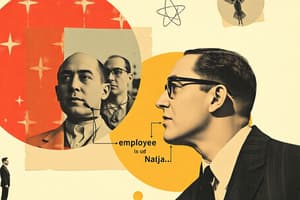Podcast
Questions and Answers
What is the main focus of Scientific Management?
What is the main focus of Scientific Management?
Maximizing efficiency through scientific means.
Who is known as the Father of Scientific Management?
Who is known as the Father of Scientific Management?
Fredrick Winslow Taylor
What are the five functions under the theory of Fayolism?
What are the five functions under the theory of Fayolism?
Planning, organizing, commanding, coordinating, and controlling.
What is the purpose of Human Relations Management?
What is the purpose of Human Relations Management?
Who proposed the hierarchy of needs?
Who proposed the hierarchy of needs?
When can the origin of HRM be traced back to?
When can the origin of HRM be traced back to?
What was significant about the first HR department established in the U.S.?
What was significant about the first HR department established in the U.S.?
HR has evolved from a purely administrative function to a strategic partner in organizations.
HR has evolved from a purely administrative function to a strategic partner in organizations.
Match the following key functions of HRM with their descriptions:
Match the following key functions of HRM with their descriptions:
What does HRM refer to?
What does HRM refer to?
Which of the following is NOT a principle of HRM?
Which of the following is NOT a principle of HRM?
What is a key distinction between HRM and Personnel Management?
What is a key distinction between HRM and Personnel Management?
Flashcards are hidden until you start studying
Study Notes
Historical evolution of HRM
- HRM has evolved from traditional personnel management to a more strategic and integrated approach.
Scientific Management
- Fredrick Winslow Taylor, an engineer, is considered the Father of Scientific Management.
- Taylorism focused on maximizing efficiency through scientific means.
- Key elements of Taylorism include:
- Time and motion studies
- Finding scientific means to increase efficiency
- Performance-based incentives
Administrative Management
- Henry Fayol, a French mining engineer, developed the theory of Fayolism.
- Fayolism established five functions and 14 principles of management.
- Key elements of Fayolism include:
- Unity of command and direction
- Division of work
- Hierarchy: Authority and Responsibility
- Centralization
Human Relations Management
- Elton Mayo, an Australian psychologist, developed the Human Relations Theory of Management.
- This theory emerged as a response to the limitations of classical management theories.
- It emphasized the importance of social factors, such as human behavior and attitudes, in the workplace.
Behavioral Management
- Behavioral approaches to management focus on creating an employee-friendly workplace culture.
- Abraham Maslow, an American psychologist, proposed the hierarchy of need, emphasizing employee needs and expectations.
Key facts about the origin of HRM
- HRM can be traced back to the 18th century, during the Industrial Revolution.
- The emergence of factories and industries led to the need for efficient workforce management.
The first HR department
- The first HR department in the United States was established by The National Cash Register Company in 1901.
HRM as a Strategic Partner
- HR has evolved from an administrative function to a strategic partner in organizations.
- HR professionals are now involved in strategic decision-making, aligning human capital with overall organizational goals.
Key functions of HRM
- Recruitment and Selection: Attracting and hiring the right talent.
- Training and Development: Enhancing employee skills and knowledge.
- Performance Management: Evaluating and managing employee performance.
Definition of HRM
- HRM refers to the strategic and systematic management of an organization's workforce to achieve its goals and objectives.
Usual Activities of the HR Department
- Recruitment
- Selection
- Training
- Performance appraisal
- Employee relations
More Complex HR Activities
- Compensation and Benefits: Designing and administering reward systems.
- Employee Relations: Handling workplace issues and conflicts.
- Compliance and Legalities: Ensuring HR practices adhere to labor laws.
- Strategic HR Planning: Aligning HR activities with organizational goals.
Key Principles of HRM
- Fairness and Equity: Treating all employees fairly and equitably.
- Transparency: Building trust through open communication.
- Legal Compliance: Adhering to labor laws and regulations.
- Communication: Encouraging open dialogue and feedback.
- EmployeeWell-being: Offering health and wellness programs and a safe working environment.
HRM vs. Personnel Management
- HRM is a more strategic and holistic approach to managing people, focusing on aligning HR practices with organizational goals.
- Personnel Management is typically seen as administrative and reactive, concerned with day-to-day employee relations.
Studying That Suits You
Use AI to generate personalized quizzes and flashcards to suit your learning preferences.




